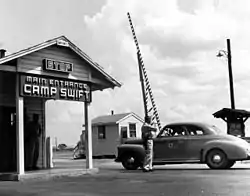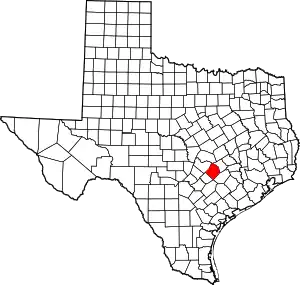Camp Swift, Texas
Camp Swift is a census-designated place (CDP) in Bastrop County, Texas, United States. The population was 7,943 at the 2020 census.[3] Camp Swift began as a United States Army training base built in 1942. It is named after Major General Eben Swift.
Camp Swift, Texas | |
|---|---|
 Main entrance to the Camp Swift facility of the 10th Mountain Division during World War II | |
 | |
| Coordinates: 30°11′2″N 97°17′52″W | |
| Country | United States |
| State | Texas |
| County | Bastrop |
| Area | |
| • Total | 12.1 sq mi (31.4 km2) |
| • Land | 12.0 sq mi (31.2 km2) |
| • Water | 0.08 sq mi (0.2 km2) |
| Elevation | 440 ft (134 m) |
| Population (2020) | |
| • Total | 7,943 |
| • Density | 660/sq mi (250/km2) |
| Time zone | UTC-6 (Central (CST)) |
| • Summer (DST) | UTC-5 (CDT) |
| Zip Code | 78602 |
| FIPS code | 48-12334[1] |
| GNIS feature ID | 1867544[2] |
History
The Army signed a $25 million contract in January 1942 to build a training camp on 56,000 acres north of Bastrop, Texas. The contract stipulated the project was to be completed in 108 working days. 2700 buildings were built during World War II, but none of those remain on the site today. At the end of the war, they were sold or donated and relocated. The gymnasium was relocated to Whitney Texas. It is still in use today by the school district.
During World War II, German prisoners of war began arriving and at peak numbered 10,000. At the same time, the camp held 90,000 GIs, making it "one of the largest army training and transshipment camps in Texas" according to Krammer.[4]
In December 1942, Sgt Walter Springs was gunned down by a White military police officer following a dispute as Springs was reporting to Camp Swift. Springs was shot in the back, but the case remains largely unsolved to this day. A memorial scholarship in his honor has been active at his alma mater, Regis University, for most of the period since 1952 and has the backing of former NBA All Star Chauncey Billups.[5]
The 10th Mountain Division trained at Camp Swift in 1944. The 2nd Infantry Division trained there mid 1945 to early 1946. The camp also trained nurses under battlefield conditions. The camp trained some 300,000 soldiers before the war ended.
Camp Swift is currently owned by the United States Government but is managed by the Texas Military Forces headquartered on Camp Mabry in Austin and acts as a training center for the National and State Guard, active armed forces, law enforcement, high school ROTC and the Civil Air Patrol. The camp is also the primary emergency staging area for Central Texas.[6]
Geography
Camp Swift is located north of the center of Bastrop County at 30°11′02″N 97°17′52″W.[8] It is about 37 miles (60 km) east of Austin and 7 miles (11 km) north of Bastrop. Texas State Highway 95 forms the western edge of the community, connecting Bastrop to the south with Elgin to the north.
According to the United States Census Bureau, the CDP has a total area of 12.1 square miles (31.4 km2), of which 12.0 square miles (31.2 km2) is land and 0.08 square miles (0.2 km2), or 0.65%, is water.[3]
Demographics
| Race | Number | Percentage |
|---|---|---|
| White (NH) | 2,476 | 31.17% |
| Black or African American (NH) | 457 | 5.75% |
| Native American or Alaska Native (NH) | 30 | 0.38% |
| Asian (NH) | 22 | 0.28% |
| Some Other Race (NH) | 37 | 0.47% |
| Mixed/Multi-Racial (NH) | 139 | 1.75% |
| Hispanic or Latino | 4,782 | 60.2% |
| Total | 7,943 |
As of the 2020 United States census, there were 7,943 people, 1,444 households, and 1,025 families residing in the CDP.
As of the census[1] of 2000, there were 4,731 people, 1,127 households, and 849 families residing in the CDP. The population density was 396.2 inhabitants per square mile (153.0/km2). There were 1,231 housing units at an average density of 103.1 per square mile (39.8/km2). The racial makeup of the CDP was 73.28% White, 8.84% African American, 1.16% Native American, 0.25% Asian, 0.06% Pacific Islander, 13.11% from other races, and 3.30% from two or more races. Hispanic or Latino of any race were 37.88% of the population.
There were 1,127 households, out of which 40.1% had children under the age of 18 living with them, 58.2% were married couples living together, 10.9% had a female householder with no husband present, and 24.6% were non-families. 19.3% of all households were made up of individuals, and 4.4% had someone living alone who was 65 years of age or older. The average household size was 2.98 and the average family size was 3.40.
In the CDP, the population was spread out, with 22.6% under the age of 18, 8.9% from 18 to 24, 42.5% from 25 to 44, 21.1% from 45 to 64, and 5.0% who were 65 years of age or older. The median age was 34 years. For every 100 females, there were 185.9 males. For every 100 females age 18 and over, there were 224.0 males.
The median income for a household in the CDP was $41,833, and the median income for a family was $44,352. Males had a median income of $30,572 versus $25,044 for females. The per capita income for the CDP was $12,829. About 9.2% of families and 11.6% of the population were below the poverty line, including 9.6% of those under age 18 and 25.7% of those age 65 or over.
Government and infrastructure
Federal Correctional Institution Bastrop, a prison of the Federal Bureau of Prisons (BOP), is in Camp Swift.[12]
Education
Camp Swift is served by the Bastrop Independent School District.[13][14] Most residents are zoned to Lost Pines Elementary School,[15] while a small southern section is zoned to Mina Elementary School.[16] All residents are zoned to Bastrop Intermediate School, Bastrop Middle School, and Bastrop High School.[17]
See also
References
- "U.S. Census website". United States Census Bureau. Retrieved January 31, 2008.
- "US Board on Geographic Names". United States Geological Survey. October 25, 2007. Retrieved January 31, 2008.
- "Geographic Identifiers: 2010 Demographic Profile Data (G001): Camp Swift CDP, Texas". U.S. Census Bureau, American Factfinder. Archived from the original on February 12, 2020. Retrieved April 9, 2014.
- Krammer, Arnold (1979). Nazi Prisoners of War in America. New York: Stein and Day. p. 90,260. ISBN 0812825713.
- Reed, Byron (May 17, 2021). "Regis University restarting scholarship named for Walter Springs". KUSA.com. Retrieved June 6, 2021.
- Crowell, Ed (December 2014). "Camp Swift". Texas Co-op Power: 26, 27.
- https://www.capmembers.com/cadet_programs/activities/encampment/winter-2016-encampments/%5B%5D
- "US Gazetteer files: 2010, 2000, and 1990". United States Census Bureau. February 12, 2011. Retrieved April 23, 2011.
- "Explore Census Data". data.census.gov. Retrieved May 24, 2022.
- http://www.census.gov
- "About the Hispanic Population and its Origin". www.census.gov. Retrieved May 18, 2022.
- "2020 CENSUS - CENSUS BLOCK MAP (INDEX): Camp Swift CDP, TX" (PDF). U.S. Census Bureau. p. 1 (PDF p. 2/3). Retrieved December 3, 2022.
Federal Correctional Institution Bastrop
- "2010 CENSUS - CENSUS BLOCK MAP: Camp Swift CDP, TX." U.S. Census Bureau. Retrieved on January 23, 2017.
- "District Boundary/Attendance Maps" (Archive). Bastrop Independent School District. Retrieved on January 23, 2017. The zone map shows most of Camp Swift as being within the Lost Pines Elementary zone with a segment in the Mina zone. "Bastrop feeder pattern: Bastrop High School, Bastrop Middle School, Bastrop Intermediate School,[...]Lost Pines Elementary,[...]"
- "Lost Pines Elementary Attendance Boundary." Bastrop Independent School District. Retrieved on January 23, 2017.
- "Mina Elementary Attendance Boundary." Bastrop Independent School District. Retrieved on January 23, 2017.
- "Bastrop ISD Attendance Boundaries." Bastrop Independent School District. Retrieved on January 23, 2017.
External links
- Camp Swift from the Handbook of Texas Online
